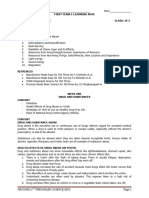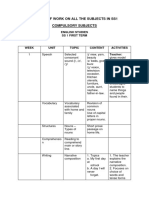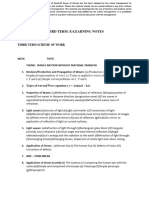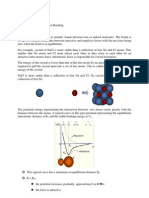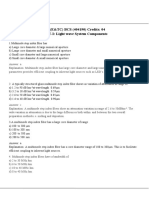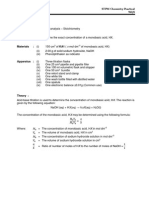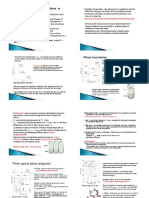TOPIC: CHEMICAL COMBINATION
CONTENTS
(a) Types of chemical bonds
(b) IUPAC system of naming inorganic compounds.
(FIRST 20 ELEMENTS)
chemical bonding is the coming together of atoms of the same or different elements, in order to
form a stable structure.
TYPES OF CHEMICAL BONDS
The attractive force between atoms when they combine chemically is called a chemical bond. There
are two main types of chemical bonds namely (i) Strong bonds (ii) Weak bonds.
(i) Strong bonds are: (a). Electrovalent (or Ionic) (b).Covalent (c).Co-ordinate (or Dative) (d). Metallic
(a) Electrovalent (Ionic) bond is defined as the electrostatic force of attraction between oppositely
charged ions. It involves the transfer of electrons from one atom, donor atom, (usually metallic) to
another atom, acceptor atom, (usually non-metallic). The electrons involved reside in the outermost
shells of the atoms and are called Valence electron(s).
IONIC COMPOUNDS are crystal lattices consisting of aggregates of oppositely charged ions.
Examples of such compounds are Sodium chlorides, calcium oxides, ammonium chlorides etc. The
formation of sodium chloride is illustrated below:
Na = 2, 8, 1 Cl =2, 8, 7
Na+= 2, 8 Cl- = 2, 8, 8
Na++ Cl-→ NaCl
Characteristics of Electrovalent bonds
i. They have high melting and boiling points
ii. They are generally soluble in water
iii .They are good conductors of electricity when molten or in solution
iv. They do not conduct electricity when solid
v. The energy needed to separate them is relatively high.
(b)Covalent bonds:This is defined as the bonds formed when two atoms donate equal numbers of
electrons and share the donated electrons to attain stable octet structure. In covalent bonding,
electrons are shared between atoms of the same or different elements such that each atom
contributes the shared electrons so as to attain stable noble gas configuration. During the process,
discrete or separate molecules are formed with covalent bonds between the atoms.
If electrons are shared between similar atoms, the donated electrons are equally shared which give
rise to a non-polar covalent bonde.g. F2, H2, O2, Cl2but if the shared pair of electrons involves two
different elements with difference in electronegativity, the electrons are then not equally shared,
this results in the formation of polar covalent bond, e.g. the formation of HCl, H2O, HF..
�Characteristics of Covalent bonds
i. Low melting and boiling points.
ii. Energy required for separation is low
iii. Do not conduct electricity in the solid or molten state, or in solution
iv. They generally have a strong, easily noticeable smell
v. They are not easily soluble in water, but are usually soluble in organic solvents
(c) Co-ordinate covalent or Dative bond involves sharing of electrons as in the normal covalent
bonding, but the shared pair is donated by only one of the participating atoms. For instance,
Ammonia and water molecules possess lone pairs and so readily enter into coordinate covalent
bonding.
(d) Metallic bond: The electrostatic force of attraction between the positive nuclei and the sea of
mobile electrons is called metallic bond. Metallic bonding, therefore, is the process whereby the
positively charged nuclei of metal atoms are simultaneously attracted to the sea (or cloud) of mobile
electrons. Metallic bond increase with increase in valence electrons of the metal. For example, in
period 3, metallic bond increases from sodium to aluminum.
(ii)Weak bonds: These are intermolecular forces of attraction that hold atoms and covalent
molecules together in gases, liquids and solids. The most common ones are: (a). Van der Waals
forces (b). Hydrogen bond (c) Dipole-Dipole (Dipolar)
(e)Van der Waals forces: They were first described by J.D. van der Waals, and are known as van der
Waals forces. They are weak short-ranged attractive forces formed between covalent molecules.
They are the only attractive forces between the atoms of the noble gases and non-polar covalent
molecules, and are responsible for the low melting and boiling point of covalent compounds. Due to
increase in van der Waals forces, there is gradation in the physical properties of the Halogens:
Fluorine and chlorine are gases; bromine is a liquid; and iodine is a solid.
Van der Waal force becomes stronger as the relative atomic mass increases among the non-metals.
(f) Hydrogen bond: This is an intermolecular force which arises when hydrogen is covalently linked
to highly electronegative elements like nitrogen, oxygen and fluorine.
The presence of hydrogen bonds between H2O molecules is responsible for water being a liquid at
room temperature and with a high boiling point; if not, it would have been a gas, like hydrogen H 2S.
HF is a liquid at room temperature, while HCl is a gas.
EVALUATION
What is a chemical bond?
List three (3) general properties of electrovalent compounds.
Define covalent bond and state its characteristicsState two (2) differences between covalent and
electrovalent compounds.
Explain the term Metallic bonding





















